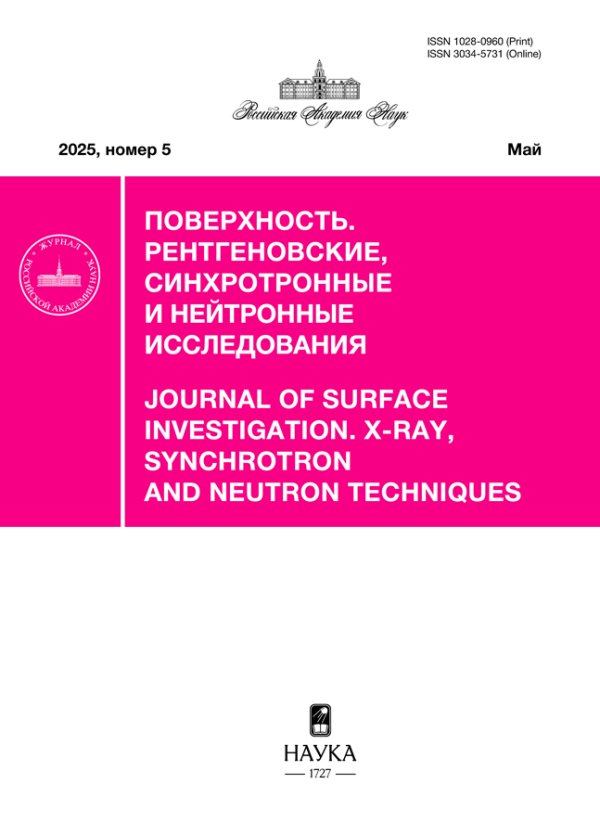Peculiarities of Interaction of Low-Energy Noble Gas Atoms with Methyl Groups on the Low-K-Surface
- Authors: Solovykh A.A.1, Sycheva A.A.2, Voronina E.N.1,2
-
Affiliations:
- Lomonosov Moscow State University
- Skobeltsyn Institute of Nuclear Physics, Moscow State University
- Issue: No 2 (2023)
- Pages: 63-70
- Section: Articles
- URL: https://journals.rcsi.science/1028-0960/article/view/137710
- DOI: https://doi.org/10.31857/S1028096023020127
- EDN: https://elibrary.ru/DSWOES
- ID: 137710
Cite item
Full Text
Abstract
In the current work the computer simulations were performed to study the possibility of surface functionalization of low-K materials that are used as interlayer insulators within ultralarge integration devices with low-energy (up to 30 eV) noble gas atoms. The simulations were carried out using the ab initio density functional theory method assisted with molecular dynamics algorithms implemented in VASP package. The detailed trajectory analysis revealed the conditions under which the irradiation of incident He, Ne, Ar, Xe atoms with the energy up to 30 eV may result in the illumination of near-surface methyl groups responsible for hydrophobic properties of dielectric surface. Based on the data obtained the threshold energy (the minimum atom energy for CH3-radical formation) was evaluated, and the mechanism peculiarities of such a process under light and heavy atom irradiation were studied. It was shown that in the energy range under consideration the interaction Ne, Ar, and Xe with methyl groups has mainly collisional mechanism, therefore with increase in mass of the incident particle the threshold energy increases. He atom irradiation, on the contrary, is capable to induce the perturbations of the electronic density around the methyl group that stimulate fast atom vibrations and result in CH3-detachment.
About the authors
A. A. Solovykh
Lomonosov Moscow State University
Email: sycheva.phys@gmail.com
Russia, 119991, Moscow
A. A. Sycheva
Skobeltsyn Institute of Nuclear Physics, Moscow State University
Author for correspondence.
Email: sycheva.phys@gmail.com
Russia, 119991, Moscow
E. N. Voronina
Lomonosov Moscow State University; Skobeltsyn Institute of Nuclear Physics, Moscow State University
Email: sycheva.phys@gmail.com
Russia, 119991, Moscow; Russia, 119991, Moscow
References
- Baklanov M.R., Ho P.S., Zschech E. Advanced Interconnects for ULSI Technology. N.Y.: Wiley & Sons, 2012. 596 p.
- Baklanov M.R., de Marneffe J.-F., Shamiryan D., Urbanowicz A.M., Shi H., Rakhimova T.V., Huang H., Ho P.S. // J. Appl. Phys. 2013. V. 113. № 4. P. 041101. https://www.doi.org/10.1063/1.4765297
- Xu H., Hu Zh.-J., Qu X.-P., Wan H., Yan Sh.-S., Li M., Chen Sh.-M., Zhao Yu-H., Zhang J., Baklanov M.R. // Appl. Surf. Sci. 2019. V. 498. P. 143887. https://www.doi.org/10.1016/j.apsusc.2019.143887
- Lionti K., Volksen W., Magbitang T., Darnon M., Dubois G. // ECS J. Solid State Sci. Technol. 2014. V. 4. № 1. P. N3071. https://www.doi.org/10.1149/2.0081501jss
- Prager L., Marsik P., Wennrich L., Baklanov M.R., Naumov, Pistol S.L., Schneider D., Gerlach J.W., Verdonck P., Buchmeiser M.R. // Microelectronic Eng. 2008. V. 85. № 10. P. 2094. https://www.doi.org/10.1016/j.mee.2008.04.039
- Lee J., Graves D.B. // J. Phys. D Appl. Phys. 2010. V. 43. № 42. P. 425201. https://www.doi.org/10.1088/0022-3727/43/42/425201
- Sycheva A.A., Voronina E.N., Rakhimova T.V., Novikov L.S., Rakhimov A.T. // J. Vac. Sci. Technol. A. 2020. V. 38. № 5. P. 053004. https://www.doi.org/10.1116/6.0000389
- Palov A.P., Proshina O.V., Rakhimova T.V., Rakhimov A.T., Voronina E.N. // Plasma Process. Polym. 2021. V. 18. P. 2100007. https://www.doi.org/10.1002/ppap.202100007
- Соловых А.А., Сычева А.А., Воронина Е.Н. // Письма в ЖТФ. 2022. Т. 48. № 7. С. 16. https://www.doi.org/10.21883/PJTF.2022.07.52286.19085
- Кон В. // УФН. 2002. Т. 172. № 3. С. 336. https://www.doi.org/10.3367/UFNr.0172.200203e.0336
- Kresse G., Joubert D. // Phys. Rev. 1999. V. 59. № 3. P. 1758. https://www.doi.org/10.1103/PhysRevB.59.1758
- Blöchl P.E. // Phys. Rev. B. 1994. V. 50. № 24. P. 17953. https://www.doi.org/10.1103/PhysRevB.50.17953
- Voevodin V.V., Antonov A.S., Nikitenko D.A., Shvets P.A., Sobolev S.I., Sidorov I.Yu., Stefanov K.S., Voevodin V.V., Zhumatiy S.A. // Supercomput. Frontiers Innovations. 2019. V. 6. № 2. P. 4. https://www.doi.org/10.14529/jsfi190201
- Perdew J.P., Burke K., Ernzerhof M. // Phys. Rev. Lett. 1996. V. 77. № 18. P. 3865. https://www.doi.org/10.1103/PhysRevLett.77.3865
- Chaudhari M., Du J. // J. Vac. Sci. & Technol. A. 2011. V. 29. № 3. P. 031303. https://www.doi.org/10.1116/1.3568963
- Rimsza J.M., Kelber J.A., Du J. // J. Phys. D: Appl. Phys. 2014. V. 47. № 33. P. 335204. https://www.doi.org/10.1088/0022-3727/47/33/335204
- Kazi H., Rimsza J., Du J. // J. Vac. Sci. Technol. A. 2014. V. 32. № 5. P. 051301. https://www.doi.org/10.1116/1.4890119
- De Darwent B. Bond Dissociation Energies in Simple Molecules. Washington: Nat. Bur. Stand, 1970. 60 p.
- Humphrey W., Dalke A., Schulten K. // J. Molec. Graphics. 1996. V. 14. № 1. P. 33. https://www.doi.org/10.1016/0263-7855(96)00018-5
- Behrisch R., Eckstein W. Sputtering by Particle Bombardment: Experiments and Computer Calculations from Threshold to MeV Energies. Berlin: Springer-Verlag, 2007. 200 p.
Supplementary files















